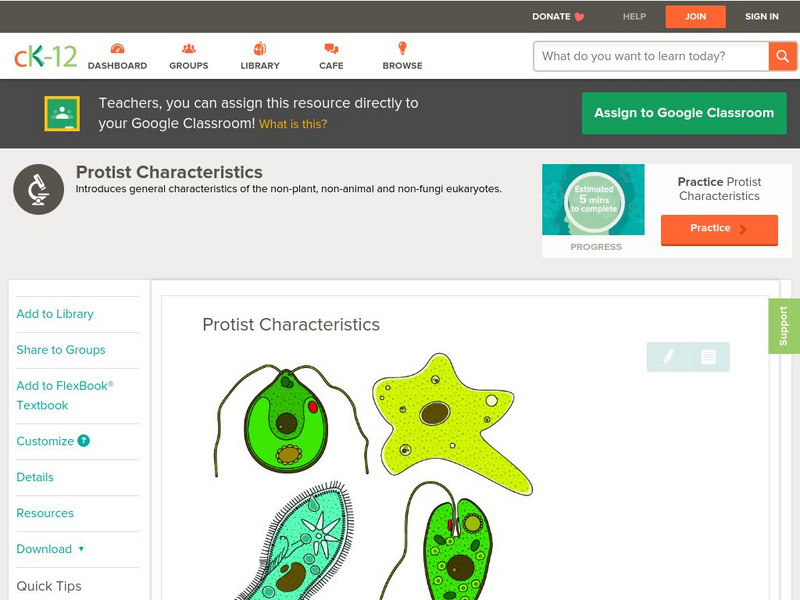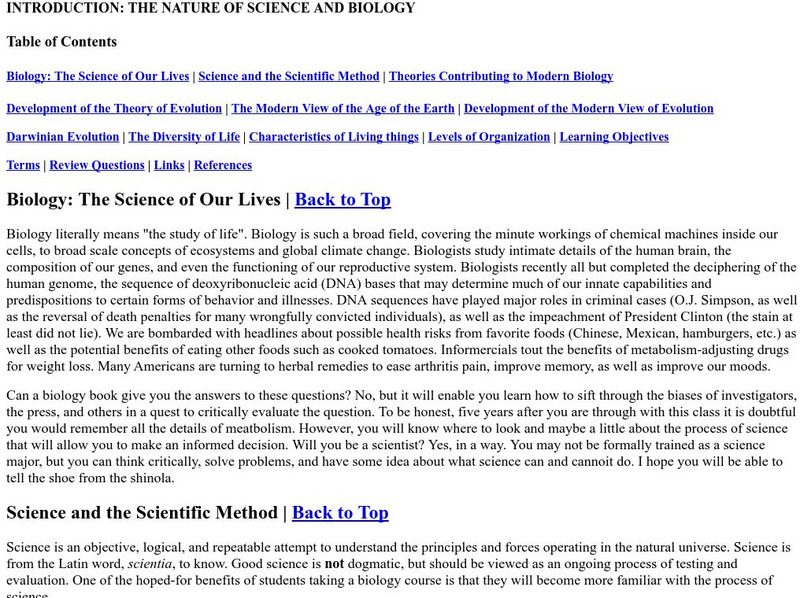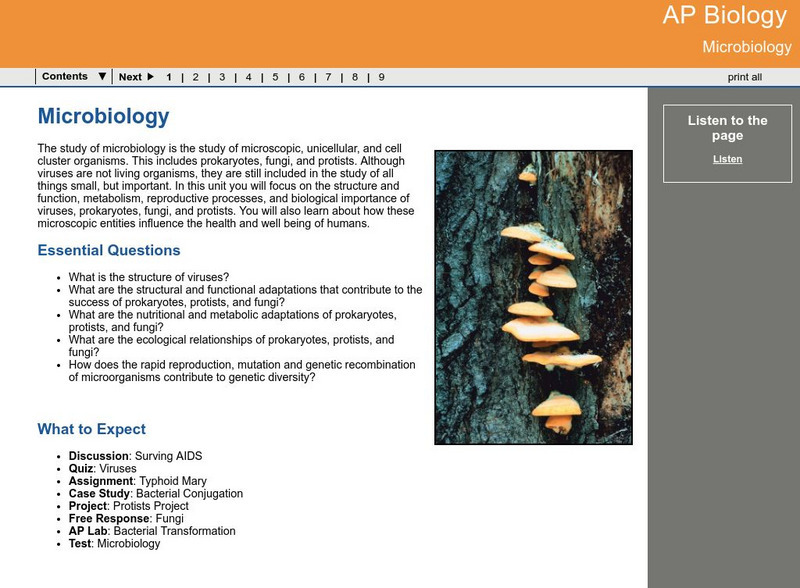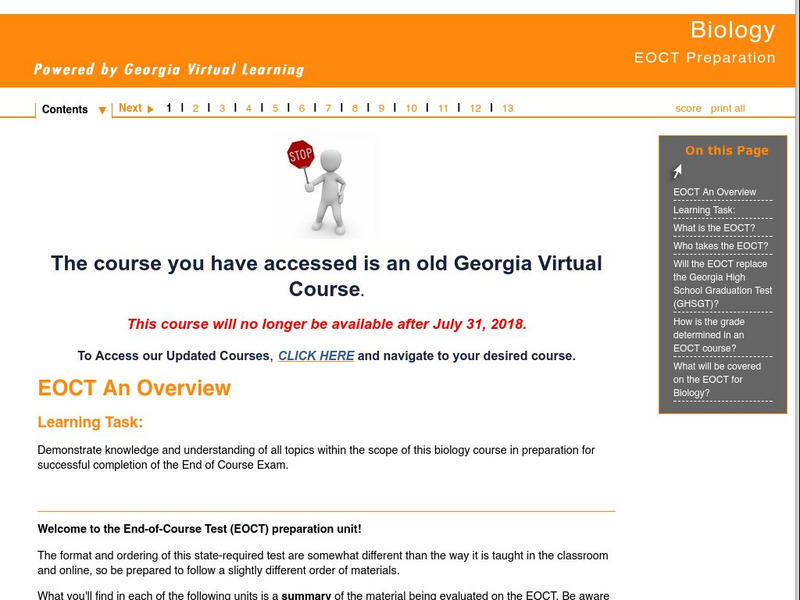Hi, what do you want to do?
Georgia Department of Education
Ga Virtual Learning: Biology: Protists and Fungi
A multi-media learning modlue immersing students in the kingdoms of fungi and protists. Activities include informational text, video clips, animations, and student assignments.
Mocomi & Anibrain Digital Technologies
Mocomi: Difference Between Algae and Fungus
Learn about fungi and how they grow, algae and the different types, and other fun facts.
BioEd Online
Bio Ed Online: The Science of Microbes: The Variety and Roles of Microbes
Middle schoolers learn about the four major groups of microbes and their characteristics, and the roles microbes have in the world. The lesson and PowerPoint slides can be downloaded. The included instructional video on the four types of...
CK-12 Foundation
Ck 12: Life Science: Protist Characteristics
[Free Registration/Login may be required to access all resource tools.] Protists are eukaryotes, which means their cells have a nucleus and other membrane-bound organelles. Most protists are single-celled. Other than these features, they...
Estrella Mountain Community College
Online Biology Book: The Nature of Science and Biology
Use the scientific reasoning and critical thinking to take an in-depth look at the basics of biology.
CK-12 Foundation
Ck 12: Life Science: Fungus Like Protists
[Free Registration/Login may be required to access all resource tools.] Fungus-like protists share many features with fungi. Like fungi, they are heterotrophs, meaning they must obtain food outside themselves. They also have cell walls...
Georgia Department of Education
Ga Virtual Learning: Ap Biology: Microbiology
In this interactive learning module, students focus on the structure and function, metabolism, reproductive processes, and biological importance of viruses, prokaryotes, fungi, and protists.
Tree of Life Project
The Tree of Life Web Project
The Tree of Life is a multi-authored, Internet distributed project containing information about phylogeny and biodiversity. The Tree of Life can be used to locate information about a particular group of organisms through their taxonomy.
Michigan State University
Michigan State University: Digital Learning Center for Microbial Ecology: Microbe Zoo
Explore the "many worlds of hidden microbes" in different areas of the Microbe Zoo: DirtLand, Animal Pavilion, Snack Bar, Space Adventure, and WaterWorld. A fun and informative resource that sheds light on the role of microbes in our...
University of California
Ucmp: Introduction to Slime Molds
This University of California Berkeley site offers a definition of slime molds, structure, and life cycle.
Other
The Domains and Kingdoms of Life
This site is a description of the history behind the 5 Kingdom system suggested by Robert Whittaker. An extensive list of resources is included.
Georgia Department of Education
Ga Virtual Learning: Biology: Eoct Preparation
Students participate in this comprehensive review to demonstrate knowledge and understanding of all topics within the scope of this biology course in preparation for successful completion of the Georgia End of Course Exam. It can also be...
Mocomi & Anibrain Digital Technologies
Mocomi: Kingdom Classification of Living Organisms
Learn about who created the classification of living things, how they are classified, and the six different kingdoms.
Biology 4 kids
Biology4 Kids: The Top Four Kingdoms
Read about the four most familiar kingdoms: fungi, plant, animal, and protist.
Open Curriculum
Open Curriculum: New Kingdoms
Between 1866 and 1977, a total of four new kingdoms were added to the original plant and animal kingdoms identified by Linnaeus. The new kingdoms include Protista (protists), Fungi, Monera (eubacteria), and Archaea (archaebacteria)....
Scholastic
Scholastic: Study Jams! Science: Plants: The Kingdoms of Life
A video, a karaoke song to sing along to, and a 7-question multiple-choice quiz on the topic of Kingdoms in the life classification system.
CK-12 Foundation
Ck 12: Life Science: Timeline of Evolution
[Free Registration/Login may be required to access all resource tools.] For life to evolve from simple single-celled organisms to many millions of species of prokaryotic species to simple eukaryotic species to all the protists, fungi,...
CK-12 Foundation
Ck 12: Biology for High School
This digital textbook covers core biology concepts and includes interactive features, real-world examples, videos, and study guides.
CK-12 Foundation
Ck 12: Life Science for Middle School
This digital textbook covers core life science concepts and includes interactive features, real-world examples, and videos.
Other
Secondary Science Program: The Six Kingdoms
A short overview of the six kingdoms in our scientific classification system: Plants, Animals, Protists, Fungi, Archaebacteria, and Eubacteria.
Curated OER
Secondary Science Program: The Six Kingdoms
A short overview of the six kingdoms in our scientific classification system: Plants, Animals, Protists, Fungi, Archaebacteria, and Eubacteria. A good explanation of how organisms are placed in their particular kingdom.
Curated OER
Secondary Science Program: The Six Kingdoms
A short overview of the six kingdoms in our scientific classification system: Plants, Animals, Protists, Fungi, Archaebacteria, and Eubacteria. A good explanation of how organisms are placed in their particular kingdom.
Curated OER
Secondary Science Program: The Six Kingdoms
A short overview of the six kingdoms in our scientific classification system: Plants, Animals, Protists, Fungi, Archaebacteria, and Eubacteria. A good explanation of how organisms are placed in their particular kingdom.
Curated OER
Secondary Science Program: The Six Kingdoms
A short overview of the six kingdoms in our scientific classification system: Plants, Animals, Protists, Fungi, Archaebacteria, and Eubacteria. A good explanation of how organisms are placed in their particular kingdom.




















